VOLUME 14 NUMBER 1 (January to June 2021)

Philipp. Sci. Lett. 2021 14 (1) 147-157
available online: June 30, 2021
*Corresponding author
Email Address: angelyn.lao@dlsu.edu.ph
Date received: February 15, 2021
Date revised: April 21, 2021
Date accepted: May 16, 2021
ARTICLE
Chemical reaction network decompositions and realizations of S-systems
Honeylou F. Farinas1,2, Eduardo R. Mendoza2,3,4,5, and Angelyn R. Lao*2,5,6
1Department of Mathematics, Mariano Marcos State University,
Ilocos Norte, 2906 Philippines
2Mathematics and Statistics Department,
De La Salle University, Manila 0922, Philippines
3Center for Natural Sciences and Environmental Research,
De La Salle University, Manila 0922, Philippines
4Max Planck Institute of Biochemistry,
Martinsried near Munich, Germany
5Faculty of Physics, Ludwig Maximilian University,
Munich 80539, Germany
6Center for Complexity and Emerging Technologies,
De La Salle University, Manila 0922, Philippines
Ilocos Norte, 2906 Philippines
2Mathematics and Statistics Department,
De La Salle University, Manila 0922, Philippines
3Center for Natural Sciences and Environmental Research,
De La Salle University, Manila 0922, Philippines
4Max Planck Institute of Biochemistry,
Martinsried near Munich, Germany
5Faculty of Physics, Ludwig Maximilian University,
Munich 80539, Germany
6Center for Complexity and Emerging Technologies,
De La Salle University, Manila 0922, Philippines
This paper presents novel decomposition classes of chemical reaction networks (CRNs) derived from S-system kinetics. Based on the network decomposition theory initiated by Feinberg in 1987, we introduce the concept of incidence independent decompositions and develop the theory of C- and C^*- decompositions which partition the set of complexes and the set of nonzero complexes respectively, including their structure theorems in terms of linkage classes. Analogous to Feinberg’s independent decomposition, we demonstrate the important relationship between sets of complex balance equilibria for an incidence independent decomposition of weakly reversible subnetworks for any kinetics. We show that the C^*-decompositions are also incidence independent. We also introduce in this paper a new realization for an S-system that is analyzed using a newly defined class of species coverable CRNs. This led to the extension of the deficiency formula and characterization of fundamental decompositions of species decomposable reaction networks.
© 2025 SciEnggJ
Philippine-American Academy of Science and Engineering